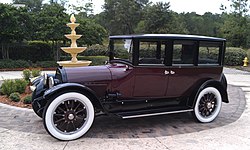| Chevrolet Superior | |
|---|---|
 1926 Chevrolet Superior Series V Touring | |
| Overview | |
| Manufacturer | Chevrolet (General Motors) |
| Model years | 1923–1926 |
| Assembly |
|
| Body and chassis | |
| Body style |
|
| Layout | front engine rear wheel drive |
| Platform | GM A platform |
| Related | |
| Powertrain | |
| Engine | 171 cu in (2.8 L) OHV I4 |
| Transmission | 3-speed manual |
| Dimensions | |
| Wheelbase | 103 in (2,616.2 mm) |
| Length | 146.06 in (3,709.9 mm) [1] |
| Width | 44.16 in (1,121.7 mm) |
| Curb weight | 1,690–2,070 lb (767–939 kg) (Series K) |
| Chronology | |
| Predecessor | |
| Successor | Chevrolet Series AA Capitol |
The Chevrolet Superior Series F was manufactured by Chevrolet from 1923 to 1926, with a different series every year. The 1923 model was known as the Series B, the 1924 model was the Series F, for 1925 it was known as the Series K and the 1926 Superior was known as the Series V. It was replaced in 1927 by the Series AA Capitol. It was the first Chevrolet that did not have a larger companion model, and was the only car sold by Chevrolet in several body style configurations, all supplied by Fisher Body. Each year new mechanical changes, appearance updates or optional features that became standard in subsequent years became expected of all GM products including Chevrolet. Body styles were separated into open, and a closed style with retractable glass in the doors and glass surrounding rear seat passengers. Standard items included tools, a jack for tire removal, speedometer, outside lockable door handles, ammeter, oil pressure gauge, dashboard light, choke pull knob, electric horn, ignition theft lock, and a two-piece vertical ventilating windshield that allowed fresh air to enter the passenger compartment. Wheels were 30 inches (760 mm) and came standard with hickory wood spokes or optional pressed steel discs. For 1925, bumpers were offered optionally along with outside side-view mirrors, heater for passenger compartment and a clock. [2]
Contents

All Superior models were powered by a 171 cu in (2.8 L) four-cylinder engine with 26 hp (19 kW) at 2000 rpm, and shared the 103 in (2,620 mm) wheelbase. The cheapest complete model, which was the Superior Roadster, cost $510 in 1926 ($9,058 in 2024 dollars [3] ), while the top-of-the-range model, the Superior Sedan, sold for US$825 ($14,653 in 2024 dollars [3] ). It was also possible to buy a chassis; the Commercial chassis cost $425, while the Express Truck chassis cost $525. Duco automotive lacquer paint, introduced by DuPont was the first quick-drying multi-color line of nitrocellulose lacquers made especially for the automotive industry. [2]
| Year | Units |
|---|---|
| 1923 | 415,814 |
| 1924 | 262,100 |
| 1925 | 444,671 |
| 1926 | 547,724 |




